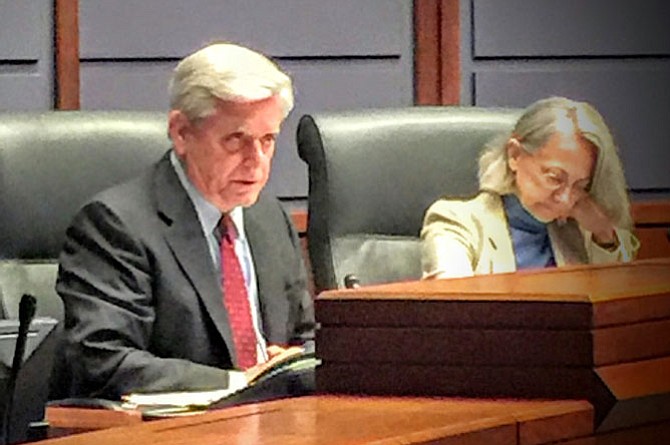Dranesville Planning Commissioner John Ulfelder said strong community input and feedback made the application to rezone Brooks Farm a much better proposal. The Planning Commission approved the plan to develop Brooks Farm into 19 houses. Photo by Ken Moore.
The Planning Commission delayed a decision on an application to rezone Brooks Farm six times in the past six months to give more time for the developer to address community concern.
Great Falls has not had a major rezoning case in a long time, Planning Commissioner John Ulfelder said Wednesday, June 15.
And the process all took in Brooks Farm rezoning application made a better proposal, he said.
“There have been a number of meetings, including walking meetings at the Brooks Farm property, with the applicant, the community, and county staff to look more closely at the issues. And, as a result, the proposed proffers and the General Development Plan have gone through a number of revisions in order to better address the various concerns,” said Ulfelder.
By a unanimous 11-0 vote, The Planning Commission approved Basheer/Edgemoore-Brooks’ application on June 15.
The rezoning, if approved by the Board of Supervisors later this year, permits developing the 52-acre property into 19 houses.
The Board will have its own public hearing; no public comment was given on the “decision only” June 15 hearing.
THE PLANNING COMMISSION held a public hearing on the case back on Jan. 21, 2016.
GFCA has opposed the application throughout the process. Numerous speakers testified, many in opposition and some in favor of the application.
More than 1,500 signed a GFCA petition opposing the project.
“At the hearing, however, a number of questions, concerns, and issues were raised, some by the Commissioners and others by neighboring property owners, Great Falls residents, and the Great Falls Citizens Association,” said Ulfelder. “During the deferral period, these same community groups have raised additional issues, as well as provided more detail about their original issues.”
The decision had been deferred six times as Great Falls Citizens Association, community members, planners, and the applicant continued to negotiate details. As just one example, the applicant made additional changes to proffers concerning stormwater retention as recently as early June.
“Is it correct to say that all of the collective measures that are now included in this plan, based on the GDP and the proffers, for stormwater retention ... significantly exceed the requirements of the Commonwealth and Fairfax County for stormwater retention and treatment, as part of this development?” Ulfelder asked Fairfax County Department of Public Works engineer Camylyn Lewis, during the decision only hearing on June 15.
“From what we can see, they’re going to exceed that,” said Lewis. “There are some measures that are also proposed, which we really don’t give them any credit for. And so they’ve really gone above.”
THE ORIGINAL PROPOSAL called for 23 houses but Basheer Edgemoore Brooks reduced that to 19 trying to reach a compromise with the community.
“The overall density on the site is now 0.365 – in the midrange of the 0.2 to 0.5 recommended in the Comprehensive Plan and comparable to the densities of the surrounding developments,” according to Ulfelder.
“Collectively, the various measures planned for this development go well beyond the minimum currently required by the Commonwealth and Fairfax County,” said Ulfelder. “They also have committed to a phased approach to the development to avoid any erosion and sediment problems that can occur during the development stage. And they have agreed to post-construction monitoring of the downstream channels for two years after completion of the project and to be responsible for any corrective restoration, if it is determined it is required,” said Ulfelder.
“IN THIS CASE a large number of local residents have spoken out in opposition to the application because of the potential environmental and other impacts of the proposed new development – and concerns about the impact of this and other future development on the semi-rural character of Great Falls,” said Ulfelder.
Developers will continue to work with Walker Lake Subdivision residents to make certain that potential runoff from the site is not causing sedimentation or water quality problems in Walker Lake.
“They also will be installing public trails through the property, working with the Great Falls Trailblazers to make them equestrian friendly, as well as for walkers and bikers,” said Ulfelder. “They have committed to various measures to reduce water consumption by the new residents, to install state-of-the-art septic systems to significantly reduce potential pollution, and to limit the amount of additional impervious area that can be added to the lots in the future. These measures, along with many others, are aimed at protecting the local environment and to make certain that it will continue to be protected into the future,” he said.
